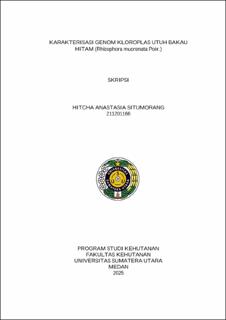| dc.description.abstract | The increasingly widespread destruction of mangrove ecosystems in Indonesia has prompted the need for conservation strategies based on genetic information. One of the important species in this ecosystem is Rhizophora mucronata, which has a high ecological and economic role. This study aims to characterize the intact chloroplast genome of R. mucronata to support genetic understanding in species conservation. The study was conducted using the Next Generation Sequencing (NGS) approach using a short-read sequencing platform that allows high accuracy in reading short DNA fragments (150–300 bp). Data were obtained from NCBI and analyzed through the stages of quality control, trimming, assembly, and annotation using bioinformatics software such as GetOrganelle and GeSeq. The results showed that the chloroplast genome of R. mucronata has a total length of 137,208 base pairs (bp) with a circular structure consisting of four main regions: Large Single Copy (LSC), Small Single Copy (SSC), and two Inverted Repeat (IR) segments. Gene annotation identified more than 100 genes, including photosystem I and II genes, cytochrome b/f complex, ATP synthase, NADH dehydrogenase, RNA polymerase, tRNA, rRNA, and hypothetical genes (ycf1 and ycf2). The genome showed a highly conservative structure, supporting the role of chloroplasts in plant adaptation to extreme tidal environments.This study emphasizes the importance of genomic data in mangrove species conservation. Characterization of the R. mucronata chloroplast genome contributes to genetic mapping, identification of population variation, and development of molecular-based conservation strategies to protect this species from the threat of extinction due to habitat degradation. | en_US |


